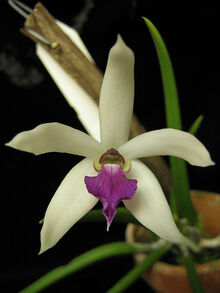| Leptotes bicolor | |||||||||||||||||
|---|---|---|---|---|---|---|---|---|---|---|---|---|---|---|---|---|---|
| |||||||||||||||||
Leptotes bicolor is a species in the genus Leptotes.
Description[]
Plant blooms in from late winter to early spring with one to three successively opening flowers. Flowers are 3.5 to 5 cm wide and are fragrant The seed pods are used as a condiment for flavoring in Brazil in ice cream.
It is a variable species, even though it is easily identified because of its bicolored flowers, white sepals and petals and purple lip; occasionally it will bear two leaves per pseudobulb. There are some records of this species living as a lithophyte.[1]
Distribution[]
Plants are found in the tropical rain forest and montane forest of Brazil and Paraguay at elevations of 500 to 900 meters
Culture[]
Plant prefer dry outs between waterings. Water about one to two times every week. Fertilize about once every two weeks during growing season. Plant grows in medium to bright light and cool to warm temperatures. Pot in perlite and medium bark or in full sphagnum moss. Plant is best mounted.
Varieties[]
| Image | Name | Description |
|---|---|---|

|
Leptotes bicolor var. alba | White sepals and petals. Lip is white. |
Taxonomy[]
In 1838, Lindley received two similar but distinct plants, collected in Macaé de Cima and Ilha Grande, in Rio de Janeiro. He considered them different to the previously described species, because the lateral lobes of the lip were slightly serrated, their flowers were bigger and they occasionally had a second leaf by the pseudobulb; he proposed a new species with the name of Leptotes serrulata.[2] Five years later, the German Count Johann Centurius von Hoffmannsegg noticed that one plant he cultivated had a different green-bluish tone to its leaves and he described the plant calling it L. glaucophylla.[3] When reviewing all the known species of Leptotes at the time, in 1990, Carl Withner revisited the drawings published by Lindley and identified additional differences between L. bicolor and L. serrulata, describing how the latter always bears more flowers, with up to seven per inflorescence, which is also much longer.[4] Today it is accepted, however, that both descriptions are variations of L. bicolor that coexist due to its wide dispersion and multiplicity of populations.
Naming[]
Common Name: Bicolored Leptotes
Synonyms[]
- Bletia bicolor Rchb.f ?
- Leptotes glaucophylla Hoffmannsegg 1843
- Leptotes serrulata Lindl. 1838
- Tetramicra bicolor [Lindley] Benth. 1883
- Tetramicra serrulata Nichols 1887
References[]
- ↑ Miller, David; Richard Warren; Izabel Moura Miller & Helmut Seehawer: Serra dos Órgãos sua história e suas orquídeas, p. 240. Rio de Janeiro, 2006.
- ↑ Lindley, John: Leptotes serrulata in Sertum orchidaceum, t.11. James Ridgway & Sons Ed. London, 1838. Published on internet.
- ↑ Hoffmannsegg, Johann Centurius von: Leptotes glaucophylla in Botanische Zeitung Vol.1, p. 833. Berlin, 1843.
- ↑ Withner, Carl Leslie: The Cattleyas and Their Relatives, Vol. 3, p.96. Timber Press, Oregon. ISBN 0881922692
